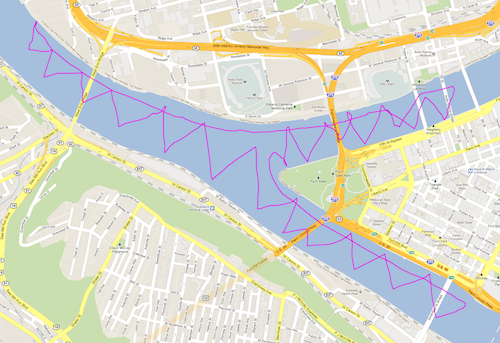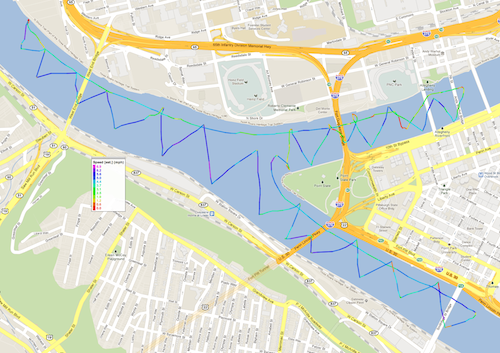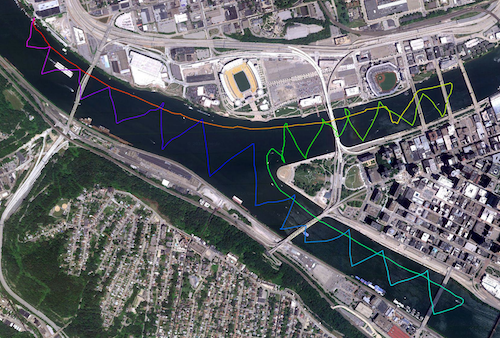Then There Were Two
August 11, 2011
This Thursday was not planned to be a sailing day. In the morning, it was hard to ignore the perfect conditions shaping up for the day. The forecast was calling for 9 mph winds from the WNW. That speed is right in the sweet spot of the Hobie Bravo. With that much wind, it flies effortlessly over the water. The temperatures had dropped to the mid to low 70s, so the exhausting heat of the earlier sails this summer would be gone. The skies were blue with happy white clouds.
It was just too good to pass up. So early in the afternoon, I closed my office door and headed off. I checked the river currents, as usual. The currents on the Ohio were bouncing up and down between 10,000 and 20,000 cubic feet per second.
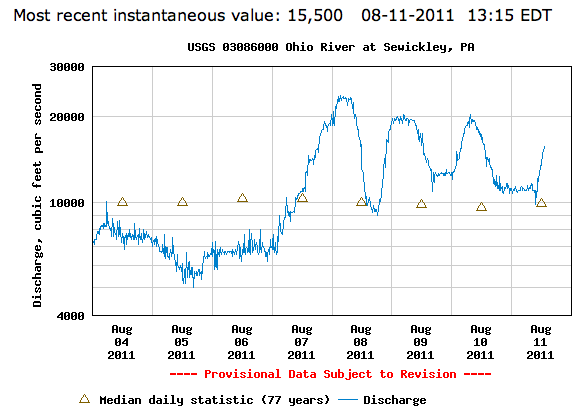
With good WNW winds, I'd have no trouble beating this current. So I didn't worry. However I did track down the source. The currents on the Mon were oscillating at the same frequency.
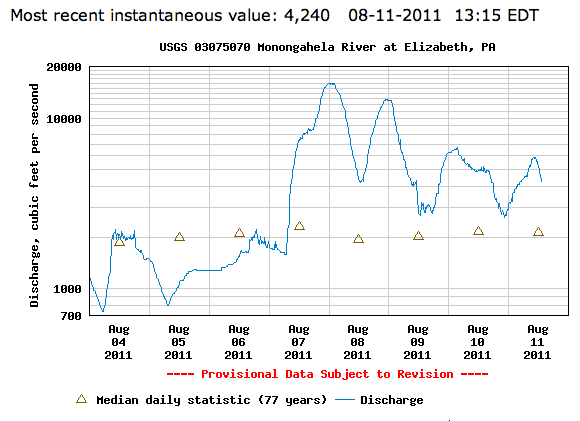
The current on the Allegheny was rising.
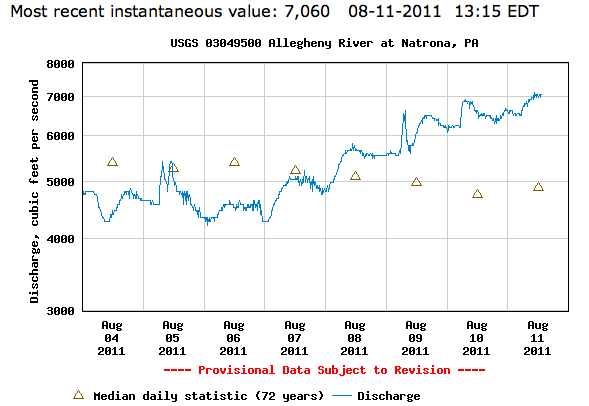
The two combined to give the Ohio flow. (The flows on the Yough were higher than usual, but less of a contributor.) Curiously, it was only the Allegheny flow web page that had a warning about sharp rises and drops, while the Allegheny was on the only river flow without them:
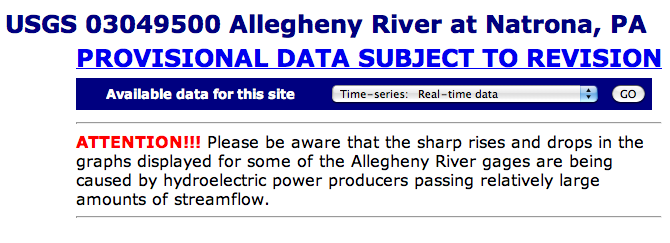
As far as the sailing went, none of this mattered. All these flows translate into currents under 0.5 mph, which are not even noticeable when there is wind. At one point in the sail, I "heaved to" in the middle of the Allegheny. That is, I had the sail furled and just drifted with "bare pole[s]" under the current and wind. Here's the detail from the speed color coded gps track:
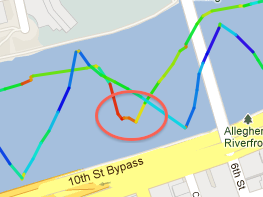
It shows that the combined effect of current and wind was to send me drifting UPstream at around 0.5 mph. That means that this current couldn't carry me away even if I wanted it to!
I have been sailing on these rivers for three summers. After each sail, I write these reports, in part to show that sailing on the rivers really is something that one can do spontaneously. There's no need for elaborate preparations, for shutting down the river to other traffic, and so on. Have your boat somewhere near the water. Keep an eye on the wind and current. When it is hospitable, go sailing!
From time to time, I get email from other sailors who are interested in sailing on the rivers in this simple and spontaneous way. Each time I look forward to the day that I'll see them out on the river. Now in my third season, that day finally came.
I put into the water at 3:25pm and and had a pleasant run to the point, enjoying the perfect wind and sunny skies:
I then turned up the Allegheny. At that moment, I felt like Robinson Crusoe seeing a human footprint in the sand. For there, farther upstream, against the backdrop of the 6th Street Bridge, was another sailboat!
It was a tiny colored triangle, barely visible. But there it was. I sailed up and heaved to in order to chat.
This second sailor is Rob Noll. He recently moved to the Northside and had emailed me a year or two ago about sailing. His boat is a small "minifish," which is a yet smaller version of the already very small sunfish. It weighs around 85 pounds, he told me as we bumped hulls in mid-river. He'd just put some wheels under it, rolled it from his home to the kayak launch under the 6th Street Bridge and slid it into the water. His "portage"--the carrying of the boat over land--was about 14 minutes, with traffic lights cooperating.
We parted since we could see a large river boat in the distance bearing down. We were pretty much in the main channel. Over the next hour or two, we sailed up and down the rivers. He went downstream while I kept my course upstream up the Allegheny. Eventually I saw him round the Point and disappear on the Mon. He reappeared on the southern shore of the Ohio and began his return. We passed again as I was heading back to the Point.
While the forecast called for WNW winds, the actual winds, as reported the next day, were NW in the 5-10 mph range. This slight northward shift meant that it was harder sailing on the Allegheny. The buildings and other things on the northern shore block and deflect the wind. I sailed up just past the 7th Street Bridge. Getting briefly becalmed, I decided I should sail back to the Point and the Mon, where I expected the winds would be better. It was tougher going on this section of the Allegheny. The winds had kicked up more chop in the water than I usually see. So I was banging through little waves but with the weaker power of sometimes erratic winds.
Here are the gps tracks:
When I turned down the Mon, the winds were as expected. They were blowing straight upstream. I had an easy run from the Point to my turn a little past the Smithfield Street Bridge. It was fast, taking only about 10 minutes. The winds seemed to be strengthening during the course of this run. The speed track shows me gaining speed during the run. I turned to tack back. It was a regular and steady return, taking 20 minutes.
There it was, I thought. My rule of thumb has been a one-to-two ratio in times for running and tacking back into the wind. The rule fitted again.
Here is the approach to Fort Pitt Bridge:
Here I am approaching the Smithfield Street Bridge, which remind me more than any other of the past elegance of Victorian engineering:
It was time to head home. The final journey from the Point to the marina took about 30 minutes. This was the fastest sailing of the say. Glancing down at the gps receiver, I noticed long stretches in which I maintained 6 mph or more while tacking into the wind. (This beat the one-to-two rule since it had taken 20 minutes on a run to go in the reverse direction, but that was with weaker winds.)
Now and again, the wind would strengthen and the boat would tip enough to "fly a hull"--that is, have one hull right out of the water. This was not something I wanted to do. If it goes too far, I tip the boat. That is not a good idea while flying (as I was) towards a weedy, tree laden shore than would complicate efforts to right the boat.
However, I was starting to get more comfortable with a hull lifting out of the water. I could feel that, if the wind wasn't too strong, the boat actually balances fairly well on one hull. If it tips more, the sail spills more wind. This effect might be enough to keep the whole set up stable, as long as there isn't too much wind.
At 5:45pm, I sailed into the dock, excusing myself to a cluster of children and adults, who were huddled round some floats. I sped through the tiny opening they'd left me.
John D. Norton
Back to main
